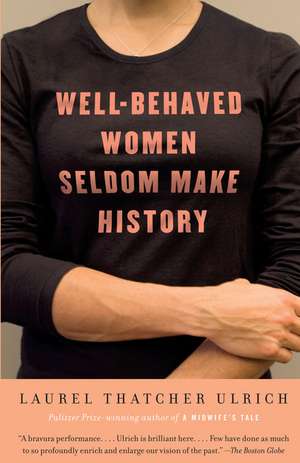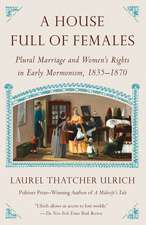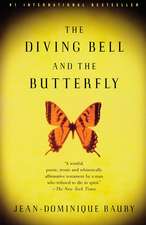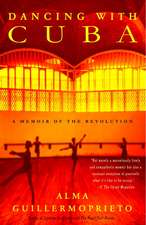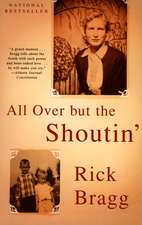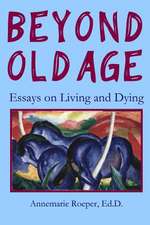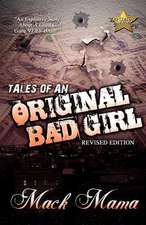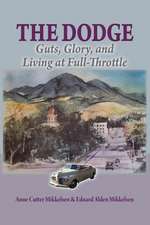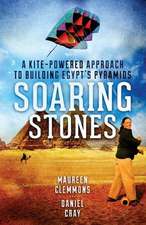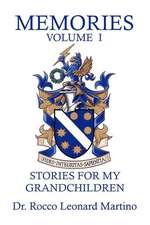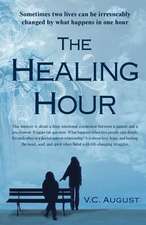Well-Behaved Women Seldom Make History
Autor Laurel Thatcher Ulrichen Limba Engleză Paperback – 31 aug 2008
In 1976, in an obscure scholarly article, Ulrich wrote, "Well behaved women seldom make history." Today these words appear on t-shirts, mugs, bumper stickers, greeting cards, and all sorts of Web sites and blogs. Ulrich explains how that happened and what it means by looking back at women of the past who challenged the way history was written. She ranges from the fifteenth-century writer Christine de Pizan, who wrote The Book of the City of Ladies, to the twentieth century’s Virginia Woolf, author of A Room of One's Own. Ulrich updates their attempts to reimagine female possibilities and looks at the women who didn't try to make history but did. And she concludes by showing how the 1970s activists who created "second-wave feminism" also created a renaissance in the study of history.
Preț: 102.99 lei
Nou
Puncte Express: 154
Preț estimativ în valută:
19.72€ • 20.34$ • 16.34£
19.72€ • 20.34$ • 16.34£
Carte disponibilă
Livrare economică 30 ianuarie-13 februarie
Preluare comenzi: 021 569.72.76
Specificații
ISBN-13: 9781400075270
ISBN-10: 1400075270
Pagini: 284
Dimensiuni: 131 x 205 x 18 mm
Greutate: 0.32 kg
Ediția:Reprint
Editura: Vintage Books USA
ISBN-10: 1400075270
Pagini: 284
Dimensiuni: 131 x 205 x 18 mm
Greutate: 0.32 kg
Ediția:Reprint
Editura: Vintage Books USA
Notă biografică
Laurel Thatcher Ulrich is currently Phillips Professor of Early American History and 300th Anniversary University Professor at Harvard. Her book A Midwife's Tale: The Life of Martha Ballard, Based on Her Diary, 1795-1812, won the Pulitzer Prize in History, the Bancroft Prize, and the American Historical Society's John H. Dunning and Joan Kelly Memorial Prizes. Ulrich's discovery of Martha Ballard and work on the diary has been chronicled in a documentary film written and produced by Laurie Kahn-Leavitt with major funding from the National Endowment for the Humanities and the American Experience television series. Ulrich is also the recipient of a MacArthur Foundation Fellowship and many other honors and awards.
Extras
Chapter One: Three Writers
Here are the stories of three women making history. One was a poet and scholar attached to a French court, another was an American activist, the third an English novelist. None was a historian in the conventional sense, but all three were determined to give women a history. The settings in which they worked were radically different. The problems they faced were surprisingly—disturbingly—the same.
For each, a moment of illumination came through an encounter with an odious book.
Paris, France, c. 1400
Christine de Pizan sat in her study. Weary of serious reading, she opened a satire someone had given her for safekeeping. She knew better than to take its diatribes against women seriously, yet somehow its arguments disturbed her. Even the sight of the book made her wonder why so many learned men had “devilish and wicked thoughts about women.” She took more volumes from their shelves. Men’s opinions spilled out like a gushing fountain, filling her with doubt. “I could hardly find a book on morals where, even before I had read it in its entirety, I did not find several chapters or certain selections attacking women, no matter who the author was.” She began to think God had made a vile creature when he created woman.[1]
In her despair she began to pray, asking why she could not have been born male. As she sat with her head bowed, tears streaming from her eyes, she discerned a beam of light falling on her lap just as a ray of sun might have done if it had been the right hour of the day. Looking up from her shadowed corner, Christine beheld a vision: standing before her were three radiant women. Terrified, she made the sign of the cross.
The first woman spoke. “Dear daughter, do not be afraid, for we have not come here to harm or trouble you, but to console you.” Identifying herself as Lady Reason, the specter held up to Christine the mirror of self-knowledge. “Come back to yourself, recover your senses, and do not trouble yourself any more over such absurdities.” She told Christine that she and her companions, Lady Rectitude and Lady Justice, had come to help her build a city in which the fame of good women would endure against all assailants. Together they would restore the reputations of those unjustly accused.[2]
Guided by her three visitors, Christine went back to books and discovered the lives of worthy women—queens, princesses, warriors, poets, inventors, weavers of tapestries, wives, mothers, sibyls, and saints. From their stories, she would build a city fit for the Queen of Heaven.
Johnstown, New York, c. 1825
Elizabeth Cady sat quietly in her father’s law office listening to the complaints of his widowed clients. Absorbing their tales of woe, she wondered why her father couldn’t do more to help them. When she asked him, Daniel Cady took a lawbook from its shelf and showed her the “inexorable statutes” that gave husbands the right to pass over their wives in favor of their sons. Married women, he explained, were civilly dead. Amused by Elizabeth’s distress, the law students in Cady’s office joined in the exercise, reading her “the worst laws they could find.” One teased her by saying that if she should grow up to become his wife, her new coral necklace and bracelets should be his. “I could take them and lock them up, and you could never wear them except with my permission. I could even exchange them for a box of cigars, and you could watch them evaporate in smoke.”[3]
Elizabeth puzzled over the power of her father’s books. When he wasn’t looking, she began to mark the offending statutes with pencil, planning “when alone in the office, to cut every one of them out of the books.” Fortunately, she confided her secret to a housekeeper, who alerted her father. Without letting her know that he had discovered her secret, he explained how laws were made, telling her that even if his entire library were to burn, it would make no difference, because there were other books and other libraries. “When you are grown up, and able to prepare a speech,” said he, “you must go down to Albany and talk to the legislators; tell them all you have seen in this office . . . and, if you can persuade them to pass new laws, the old ones will be a dead letter.”[4]
Elizabeth vowed to do just that. When she grew up she would not only go down to Albany but journey across the Atlantic and throughout the United States in defense of women’s rights.
London, England, 1928
Virginia Woolf, or one of her fictional personae (“call me Mary Beton, Mary Seton, Mary Carmichael or by any name you please”), sat in the domed reading room of the British Museum, surrounded by books. She had returned from giving a lecture at Cambridge with her head full of questions. “Why was one sex so prosperous and the other so poor?” Surely the cached wisdom of a great library would provide answers. Surrounded by books, she lifted her pencil and prepared to begin, but no sooner had she written WOMEN AND POVERTY in block letters on a page of her notebook, than the enormity of her task confronted her.[5]
The more notes she took, the more confused she became. “Professors, schoolmasters, sociologists, clergymen, novelists, essayists, journalists, men who had no qualification save that they were not women, chased my simple and single question—Why are women poor?—until it became fifty questions; until the fifty questions leapt frantically into mid-stream and were carried away.” Pausing in her labors, she began to doodle. Before she knew it, she had drawn a figure she called “Professor von X, engaged in writing his monumental work entitled The Mental, Moral, and Physical Inferiority of the Female Sex.” The Professor was not a man attractive to women. “He was heavily built; he had a great jowl; to balance that he had very small eyes; he was very red in the face.” Where had this phantom come from? Alas, from the morning’s reading. Somewhere in that pile of books was a statement that had aroused a demon. That was hardly surprising. No woman likes to be told she is “naturally the inferior of a little man.” Woolf looked at the unshaven student next to her and “began drawing cart-wheels and circles over the angry professor’s face till he looked like a burning bush or flaming comet—anyhow, an apparition without human semblance or significance. The professor was nothing now but a faggot burning on the top of Hampstead Heath.”[6]
She returned the books to the center desk, and went to lunch. She had failed in her quest, but she had stumbled on anger—not just her own, but the anger of professors who liked to write about women. Why was it, she asked, that those who ruled the world felt the need to diminish women? Was anger, she wondered, “the familiar, the attendant sprite on power?”[7]
Little matter. For the moment at least, she had banished the Professor. With money and a room of her own, she would write her own books.[8]
Three Writers Making History
In each of these stories, a studious female discovers male disdain for women, and that discovery leads to a new mission. Christine de Pizan’s story appears in the opening pages of her Book of the City of Ladies, a sophisticated allegory that remains, six centuries later, an accessible and provocative collection of female biographies. Elizabeth Cady Stanton told her story in Chapter II of Eighty Years and More, an autobiographical account of her fifty-year fight for women’s suffrage. Virginia Woolf’s vignette appears in A Room of One’s Own, a semifictional essay that began as a pair of lectures given at the women’s colleges at Cambridge University in 1928.
Christine lived in the age before printing. The books she read (and sometimes helped produce) were handwritten, and so precious that only those with great wealth or access to noble libraries might read them. Elizabeth Cady Stanton was born four hundred years later in a rural village in a new American republic. Her father’s library, which contained classics of English literature as well as legal tomes, was a symbol of middle-class respectability in a nation proud of its revolutionary heritage. In contrast, the library where Woolf worked was an imperial behemoth. The British Museum prided itself on gathering under its roof the national literatures as well as the material artifacts of other nations. By 1912 it claimed to have not only the largest library in the world but the only one of any consequence possessing a complete printed catalog of its collections. Woolf was both impressed with and disdainful of its systems. “London,” she wrote, “was like a workshop. . . . The British Museum was another department of the factory.”[9]
Given such radical differences in setting, the similarity between the three stories is striking. There is no question of influence. Stanton and Woolf may have heard of Christine, but they could not have read her work. The City of Ladies, written in medieval French in 1405, was not accessible in modern French or English until the 1980s. Only specialists consulted the manuscript compendium of Christine’s work that had long been in the British Museum.[10] Nor is there any indication that Woolf read Stanton, or that if she had she would have been pleased. The narrator of A Room of One’s Own dismisses old-fashioned suffragists and their cause, explaining that on the very day Parliament gave the vote to women, she received a legacy from an aunt who had died in India. “Of the two—the vote and the money—the money, I own, seemed infinitely more important.”[11]
Yet there are intriguing parallels in the lives of the three writers. All had intellectual fathers, domestic mothers. All three were raised in settings that simultaneously encouraged and thwarted their love of learning. All three married men who supported their intellectual ambitions. All three lived through the wrenching deaths of loved ones and terrifying, fratricidal warfare—the Hundred Years War in Christine’s case, the American Civil War in Stanton’s, and World War I for Woolf. All three identified with women yet imagined becoming male. In their work and in their lives, all three writers addressed an enduring puzzle: Are differences between the sexes innate or learned? Using stories about the past to challenge history, they talked back to books.
Today, other writers talk back to them. Historians from regions Christine knew only through myth now return the European gaze. In the United States, descendants of the slaves Stanton wrote about with amused condescension now teach in leading law schools and preside in courts. In Woolf’s London, books as well as legacies arrive from Bombay. Meanwhile, all three writers have become icons themselves. Images from Christine’s illuminated manuscripts grace websites, datebooks, and calendars. Stanton’s home in Seneca Falls, New York, is now part of a Women’s Rights National Historical Park. Woolf’s face appears on T-shirts and postcards.
Their canonical status ensures criticism as well as applause. Medievalists debate Christine’s significance, and feminists tangle over the meaning of her books. Is her fame deserved, or an artifact of her sex? Were her ideas revolutionary or conventional? Did she, like many high-achieving women, secure her own reputation by validating traditions she herself surmounted? Students of the women’s rights movement are no more settled about Stanton. Was she a path-breaker or a skilled publicist who exaggerated her own oppression and ignored the contributions of others? Woolf has provoked even more powerful reactions. Was she, like the writers she wrote about, a “madwoman in the attic” and a victim of patriarchy? If so, by what devious path did she become the repressed nightmare in Edward Albee’s play Who’s Afraid of Virginia Woolf? Or the inspiration for a supposedly liberated cigarette called “Virginia Slims”? In 1998, her life and death and her novel Mrs. Dalloway inspired Michael Cunningham’s The Hours, which won a Pulitzer Prize for fiction and, in the film version, an Academy Award for Nicole Kidman. And yet, despite the affection they display for Woolf, the novel and the film have her drowning herself years before her actual death.
Christine de Pizan, Elizabeth Cady Stanton, and Virginia Woolf continue to make history. For those who would understand how and why their stories matter, their books are a place to begin.
The City of Ladies: Celebrating Exemplary Women
Christine grew up in a glittering though uncertain world. Born in Italy in 1365, she was three years old when her father, Tommaso di Benvenuto da Pizzano, became a “philosopher, servant, and counselor” to the French monarch Charles V. The king and his three brothers—Louis, Jean, and Philippe—rivaled each other in their commitment to literature and the arts. They commissioned masterworks in stone, stained glass, textiles, and metal, and gathered around them writers, scholars, and poets. Charles’s library at the Louvre eventually contained nine hundred volumes, an extraordinary achievement in a world where the richest man might own no more than fifty books. In an era when books were complex works of art encrusted with gold leaf and precious stones and bound in silk, royal patronage created work for preparers of parchment, paint-makers, goldsmiths, illuminators, scholars, translators, and scribes. Christine became part of this circle.[12]
Raised in the shadow of the court, she had an unusually fine education, though she later wrote that she didn’t really appreciate it until misfortune forced her to use it. When she was fifteen, she married Etienne du Castel, a twenty-four-year-old scholar of noble birth who soon became the king’s clerk and notary. Of her marriage she later wrote, “We had so arranged our love and our two hearts that we had but one will, closer than brother and sister, whether in joy or in sorrow.” But their happiness was precarious. Soon after her marriage, Christine’s father lost his position, then died. In 1389, her husband too passed away. At age twenty-five, she was left a widow with a mother, two brothers, and three children of her own to support.[13]
She began by using her skills in penmanship to work as a scribe and copyist. Even after she became a writer herself, she continued to supervise copying. Scholars have identified at least fifty-five manuscripts written in whole or in part in her hand. She was proud of her work, and included in several of her own books an image of herself in her study. One now at the British Museum shows her dressed in a modest blue gown and white headdress, sitting at a cloth-covered table with a tiny dog at her side. Although she appears here as a solitary figure, she did not work alone. In The City of Ladies, for example she praises a female artist named Anastasia, noting that “she has executed several things for me which stand out among the ornamental borders of the great masters.”[14]
Christine wrote in most of the major genres of her day. She penned the official biography of Charles V, produced love lyrics, history, and allegory, and even completed a manual on military strategy. She fully understood that in becoming a scholar and a writer, she had intruded into the world of men. In 1401, shortly before writing The Book of the City of Ladies, she was drawn into a literary debate over the merits of an allegorical poem called The Romance of the Rose. She deplored its portrayal of women as vain, inconstant, and lewd. In turn, the poem’s defenders dismissed her as incompetent. One begged her, as a “woman of great ingenuity,” not to exceed her talents; “if you have been praised because you have shot a bullet over the towers of Notre Dame, don’t try to hit the moon.”[15]
NOTES
[1] Christine de Pizan, The Book of the City of Ladies, ed. Earl Jeffrey Richards (New York: Persea Books, rev. ed., 1998), pp. 3-5.
[2] Ibid., pp. 6, 12-14.
[3] Elizabeth Cady Stanton, Eighty Years and More: Reminiscences 1815-1897 (New York: Schocken Books, 1971, orig. pub. T. Fisher Unwin, 1898), pp. 30-32.
[4] Ibid., p.32.
[5] Virginia Woolf, A Room of One's Own (San Diego, New York, London: Harcourt Brave Jovanovich, 1981, orig. 1929), pp. 8, 25, 26.
[6] Ibid., pp. 28, 31-32.
[7] Ibid., pp. 32, 33-34.
[8] Ibid., pp. 37, 39.
[9] Ibid., p. 26; R. Q. Peddie, The British Museum Reading Room: A Handbook for Students (London: Grafton, 1912), pp. 2,3.
[10] Richards, Introduction to Pizan, Ladies, p. xlviii.
[11] Room of One's Own, p. 37. When the British House of Lords passed the women's suffrage bill in 1918, Woolf told her diary, "I don't feel much more important—perhaps slightly less so." The Diary of Virginia Woolf, eds. Anne Olivier Bell and Andrew McNeillie, vol. 1 (London: Hogarth Press, 1977), p. 104, quoted in Hermione Lee, Virginia Woolf (New York: Vintage, 1999), p. 339.
[12] Charity Cannon Willard, Christine de Pizan: Her Life and Works (New York: Persea Books, 1984), pp. 15-32. For a brief survey, with illustrations of art productions during her lifetime, see "Patronage at the Early Valois Courts, 1328-1469 A.D.," on a Timeline of Art History, Metropolitan Museum of Art, New York, http://www.metmuseum.org/toah/hd/valo_2/hd_valo_2.htm. On manuscript production, see Jonathan J. G. Alexander, Medieval Illuminators and Their Methods of Work (New Haven and London: Yale University Press, 1992), pp. 35-51, and on Paris in particular, Brigitte Buettner, Boccaccio's Des cleres et nobles femmes: Systems of Signification in an Illuminated Manuscript (Seattle and London: University of Washington Press, 1996), pp. 4-24.
[13] Williard, Christine de Pizan, 39-40; Enid McLeod, The Order of the Rose: The Life and Ideas of Christine de Pizan (London: Chatto & Windus, 1976), pp. 1-33.
[14] Lesley Smith, "Scriba, Femina: Medieval Depictions of Women Writing," in Lesley Smith and Jane H. M. Taylor, Women and the Book: Assessing the Visual Evidence (British Library and University of Toronto Press, 1996), pp. 26-27; Willard, Christine de Pizan, p. 47; Pizan, Ladies, 1.41.4, p. 85.
[15] Willard, Christine de Pizan, pp. 47, 51, 73, 84.
From the Hardcover edition.
Here are the stories of three women making history. One was a poet and scholar attached to a French court, another was an American activist, the third an English novelist. None was a historian in the conventional sense, but all three were determined to give women a history. The settings in which they worked were radically different. The problems they faced were surprisingly—disturbingly—the same.
For each, a moment of illumination came through an encounter with an odious book.
Paris, France, c. 1400
Christine de Pizan sat in her study. Weary of serious reading, she opened a satire someone had given her for safekeeping. She knew better than to take its diatribes against women seriously, yet somehow its arguments disturbed her. Even the sight of the book made her wonder why so many learned men had “devilish and wicked thoughts about women.” She took more volumes from their shelves. Men’s opinions spilled out like a gushing fountain, filling her with doubt. “I could hardly find a book on morals where, even before I had read it in its entirety, I did not find several chapters or certain selections attacking women, no matter who the author was.” She began to think God had made a vile creature when he created woman.[1]
In her despair she began to pray, asking why she could not have been born male. As she sat with her head bowed, tears streaming from her eyes, she discerned a beam of light falling on her lap just as a ray of sun might have done if it had been the right hour of the day. Looking up from her shadowed corner, Christine beheld a vision: standing before her were three radiant women. Terrified, she made the sign of the cross.
The first woman spoke. “Dear daughter, do not be afraid, for we have not come here to harm or trouble you, but to console you.” Identifying herself as Lady Reason, the specter held up to Christine the mirror of self-knowledge. “Come back to yourself, recover your senses, and do not trouble yourself any more over such absurdities.” She told Christine that she and her companions, Lady Rectitude and Lady Justice, had come to help her build a city in which the fame of good women would endure against all assailants. Together they would restore the reputations of those unjustly accused.[2]
Guided by her three visitors, Christine went back to books and discovered the lives of worthy women—queens, princesses, warriors, poets, inventors, weavers of tapestries, wives, mothers, sibyls, and saints. From their stories, she would build a city fit for the Queen of Heaven.
Johnstown, New York, c. 1825
Elizabeth Cady sat quietly in her father’s law office listening to the complaints of his widowed clients. Absorbing their tales of woe, she wondered why her father couldn’t do more to help them. When she asked him, Daniel Cady took a lawbook from its shelf and showed her the “inexorable statutes” that gave husbands the right to pass over their wives in favor of their sons. Married women, he explained, were civilly dead. Amused by Elizabeth’s distress, the law students in Cady’s office joined in the exercise, reading her “the worst laws they could find.” One teased her by saying that if she should grow up to become his wife, her new coral necklace and bracelets should be his. “I could take them and lock them up, and you could never wear them except with my permission. I could even exchange them for a box of cigars, and you could watch them evaporate in smoke.”[3]
Elizabeth puzzled over the power of her father’s books. When he wasn’t looking, she began to mark the offending statutes with pencil, planning “when alone in the office, to cut every one of them out of the books.” Fortunately, she confided her secret to a housekeeper, who alerted her father. Without letting her know that he had discovered her secret, he explained how laws were made, telling her that even if his entire library were to burn, it would make no difference, because there were other books and other libraries. “When you are grown up, and able to prepare a speech,” said he, “you must go down to Albany and talk to the legislators; tell them all you have seen in this office . . . and, if you can persuade them to pass new laws, the old ones will be a dead letter.”[4]
Elizabeth vowed to do just that. When she grew up she would not only go down to Albany but journey across the Atlantic and throughout the United States in defense of women’s rights.
London, England, 1928
Virginia Woolf, or one of her fictional personae (“call me Mary Beton, Mary Seton, Mary Carmichael or by any name you please”), sat in the domed reading room of the British Museum, surrounded by books. She had returned from giving a lecture at Cambridge with her head full of questions. “Why was one sex so prosperous and the other so poor?” Surely the cached wisdom of a great library would provide answers. Surrounded by books, she lifted her pencil and prepared to begin, but no sooner had she written WOMEN AND POVERTY in block letters on a page of her notebook, than the enormity of her task confronted her.[5]
The more notes she took, the more confused she became. “Professors, schoolmasters, sociologists, clergymen, novelists, essayists, journalists, men who had no qualification save that they were not women, chased my simple and single question—Why are women poor?—until it became fifty questions; until the fifty questions leapt frantically into mid-stream and were carried away.” Pausing in her labors, she began to doodle. Before she knew it, she had drawn a figure she called “Professor von X, engaged in writing his monumental work entitled The Mental, Moral, and Physical Inferiority of the Female Sex.” The Professor was not a man attractive to women. “He was heavily built; he had a great jowl; to balance that he had very small eyes; he was very red in the face.” Where had this phantom come from? Alas, from the morning’s reading. Somewhere in that pile of books was a statement that had aroused a demon. That was hardly surprising. No woman likes to be told she is “naturally the inferior of a little man.” Woolf looked at the unshaven student next to her and “began drawing cart-wheels and circles over the angry professor’s face till he looked like a burning bush or flaming comet—anyhow, an apparition without human semblance or significance. The professor was nothing now but a faggot burning on the top of Hampstead Heath.”[6]
She returned the books to the center desk, and went to lunch. She had failed in her quest, but she had stumbled on anger—not just her own, but the anger of professors who liked to write about women. Why was it, she asked, that those who ruled the world felt the need to diminish women? Was anger, she wondered, “the familiar, the attendant sprite on power?”[7]
Little matter. For the moment at least, she had banished the Professor. With money and a room of her own, she would write her own books.[8]
Three Writers Making History
In each of these stories, a studious female discovers male disdain for women, and that discovery leads to a new mission. Christine de Pizan’s story appears in the opening pages of her Book of the City of Ladies, a sophisticated allegory that remains, six centuries later, an accessible and provocative collection of female biographies. Elizabeth Cady Stanton told her story in Chapter II of Eighty Years and More, an autobiographical account of her fifty-year fight for women’s suffrage. Virginia Woolf’s vignette appears in A Room of One’s Own, a semifictional essay that began as a pair of lectures given at the women’s colleges at Cambridge University in 1928.
Christine lived in the age before printing. The books she read (and sometimes helped produce) were handwritten, and so precious that only those with great wealth or access to noble libraries might read them. Elizabeth Cady Stanton was born four hundred years later in a rural village in a new American republic. Her father’s library, which contained classics of English literature as well as legal tomes, was a symbol of middle-class respectability in a nation proud of its revolutionary heritage. In contrast, the library where Woolf worked was an imperial behemoth. The British Museum prided itself on gathering under its roof the national literatures as well as the material artifacts of other nations. By 1912 it claimed to have not only the largest library in the world but the only one of any consequence possessing a complete printed catalog of its collections. Woolf was both impressed with and disdainful of its systems. “London,” she wrote, “was like a workshop. . . . The British Museum was another department of the factory.”[9]
Given such radical differences in setting, the similarity between the three stories is striking. There is no question of influence. Stanton and Woolf may have heard of Christine, but they could not have read her work. The City of Ladies, written in medieval French in 1405, was not accessible in modern French or English until the 1980s. Only specialists consulted the manuscript compendium of Christine’s work that had long been in the British Museum.[10] Nor is there any indication that Woolf read Stanton, or that if she had she would have been pleased. The narrator of A Room of One’s Own dismisses old-fashioned suffragists and their cause, explaining that on the very day Parliament gave the vote to women, she received a legacy from an aunt who had died in India. “Of the two—the vote and the money—the money, I own, seemed infinitely more important.”[11]
Yet there are intriguing parallels in the lives of the three writers. All had intellectual fathers, domestic mothers. All three were raised in settings that simultaneously encouraged and thwarted their love of learning. All three married men who supported their intellectual ambitions. All three lived through the wrenching deaths of loved ones and terrifying, fratricidal warfare—the Hundred Years War in Christine’s case, the American Civil War in Stanton’s, and World War I for Woolf. All three identified with women yet imagined becoming male. In their work and in their lives, all three writers addressed an enduring puzzle: Are differences between the sexes innate or learned? Using stories about the past to challenge history, they talked back to books.
Today, other writers talk back to them. Historians from regions Christine knew only through myth now return the European gaze. In the United States, descendants of the slaves Stanton wrote about with amused condescension now teach in leading law schools and preside in courts. In Woolf’s London, books as well as legacies arrive from Bombay. Meanwhile, all three writers have become icons themselves. Images from Christine’s illuminated manuscripts grace websites, datebooks, and calendars. Stanton’s home in Seneca Falls, New York, is now part of a Women’s Rights National Historical Park. Woolf’s face appears on T-shirts and postcards.
Their canonical status ensures criticism as well as applause. Medievalists debate Christine’s significance, and feminists tangle over the meaning of her books. Is her fame deserved, or an artifact of her sex? Were her ideas revolutionary or conventional? Did she, like many high-achieving women, secure her own reputation by validating traditions she herself surmounted? Students of the women’s rights movement are no more settled about Stanton. Was she a path-breaker or a skilled publicist who exaggerated her own oppression and ignored the contributions of others? Woolf has provoked even more powerful reactions. Was she, like the writers she wrote about, a “madwoman in the attic” and a victim of patriarchy? If so, by what devious path did she become the repressed nightmare in Edward Albee’s play Who’s Afraid of Virginia Woolf? Or the inspiration for a supposedly liberated cigarette called “Virginia Slims”? In 1998, her life and death and her novel Mrs. Dalloway inspired Michael Cunningham’s The Hours, which won a Pulitzer Prize for fiction and, in the film version, an Academy Award for Nicole Kidman. And yet, despite the affection they display for Woolf, the novel and the film have her drowning herself years before her actual death.
Christine de Pizan, Elizabeth Cady Stanton, and Virginia Woolf continue to make history. For those who would understand how and why their stories matter, their books are a place to begin.
The City of Ladies: Celebrating Exemplary Women
Christine grew up in a glittering though uncertain world. Born in Italy in 1365, she was three years old when her father, Tommaso di Benvenuto da Pizzano, became a “philosopher, servant, and counselor” to the French monarch Charles V. The king and his three brothers—Louis, Jean, and Philippe—rivaled each other in their commitment to literature and the arts. They commissioned masterworks in stone, stained glass, textiles, and metal, and gathered around them writers, scholars, and poets. Charles’s library at the Louvre eventually contained nine hundred volumes, an extraordinary achievement in a world where the richest man might own no more than fifty books. In an era when books were complex works of art encrusted with gold leaf and precious stones and bound in silk, royal patronage created work for preparers of parchment, paint-makers, goldsmiths, illuminators, scholars, translators, and scribes. Christine became part of this circle.[12]
Raised in the shadow of the court, she had an unusually fine education, though she later wrote that she didn’t really appreciate it until misfortune forced her to use it. When she was fifteen, she married Etienne du Castel, a twenty-four-year-old scholar of noble birth who soon became the king’s clerk and notary. Of her marriage she later wrote, “We had so arranged our love and our two hearts that we had but one will, closer than brother and sister, whether in joy or in sorrow.” But their happiness was precarious. Soon after her marriage, Christine’s father lost his position, then died. In 1389, her husband too passed away. At age twenty-five, she was left a widow with a mother, two brothers, and three children of her own to support.[13]
She began by using her skills in penmanship to work as a scribe and copyist. Even after she became a writer herself, she continued to supervise copying. Scholars have identified at least fifty-five manuscripts written in whole or in part in her hand. She was proud of her work, and included in several of her own books an image of herself in her study. One now at the British Museum shows her dressed in a modest blue gown and white headdress, sitting at a cloth-covered table with a tiny dog at her side. Although she appears here as a solitary figure, she did not work alone. In The City of Ladies, for example she praises a female artist named Anastasia, noting that “she has executed several things for me which stand out among the ornamental borders of the great masters.”[14]
Christine wrote in most of the major genres of her day. She penned the official biography of Charles V, produced love lyrics, history, and allegory, and even completed a manual on military strategy. She fully understood that in becoming a scholar and a writer, she had intruded into the world of men. In 1401, shortly before writing The Book of the City of Ladies, she was drawn into a literary debate over the merits of an allegorical poem called The Romance of the Rose. She deplored its portrayal of women as vain, inconstant, and lewd. In turn, the poem’s defenders dismissed her as incompetent. One begged her, as a “woman of great ingenuity,” not to exceed her talents; “if you have been praised because you have shot a bullet over the towers of Notre Dame, don’t try to hit the moon.”[15]
NOTES
[1] Christine de Pizan, The Book of the City of Ladies, ed. Earl Jeffrey Richards (New York: Persea Books, rev. ed., 1998), pp. 3-5.
[2] Ibid., pp. 6, 12-14.
[3] Elizabeth Cady Stanton, Eighty Years and More: Reminiscences 1815-1897 (New York: Schocken Books, 1971, orig. pub. T. Fisher Unwin, 1898), pp. 30-32.
[4] Ibid., p.32.
[5] Virginia Woolf, A Room of One's Own (San Diego, New York, London: Harcourt Brave Jovanovich, 1981, orig. 1929), pp. 8, 25, 26.
[6] Ibid., pp. 28, 31-32.
[7] Ibid., pp. 32, 33-34.
[8] Ibid., pp. 37, 39.
[9] Ibid., p. 26; R. Q. Peddie, The British Museum Reading Room: A Handbook for Students (London: Grafton, 1912), pp. 2,3.
[10] Richards, Introduction to Pizan, Ladies, p. xlviii.
[11] Room of One's Own, p. 37. When the British House of Lords passed the women's suffrage bill in 1918, Woolf told her diary, "I don't feel much more important—perhaps slightly less so." The Diary of Virginia Woolf, eds. Anne Olivier Bell and Andrew McNeillie, vol. 1 (London: Hogarth Press, 1977), p. 104, quoted in Hermione Lee, Virginia Woolf (New York: Vintage, 1999), p. 339.
[12] Charity Cannon Willard, Christine de Pizan: Her Life and Works (New York: Persea Books, 1984), pp. 15-32. For a brief survey, with illustrations of art productions during her lifetime, see "Patronage at the Early Valois Courts, 1328-1469 A.D.," on a Timeline of Art History, Metropolitan Museum of Art, New York, http://www.metmuseum.org/toah/hd/valo_2/hd_valo_2.htm. On manuscript production, see Jonathan J. G. Alexander, Medieval Illuminators and Their Methods of Work (New Haven and London: Yale University Press, 1992), pp. 35-51, and on Paris in particular, Brigitte Buettner, Boccaccio's Des cleres et nobles femmes: Systems of Signification in an Illuminated Manuscript (Seattle and London: University of Washington Press, 1996), pp. 4-24.
[13] Williard, Christine de Pizan, 39-40; Enid McLeod, The Order of the Rose: The Life and Ideas of Christine de Pizan (London: Chatto & Windus, 1976), pp. 1-33.
[14] Lesley Smith, "Scriba, Femina: Medieval Depictions of Women Writing," in Lesley Smith and Jane H. M. Taylor, Women and the Book: Assessing the Visual Evidence (British Library and University of Toronto Press, 1996), pp. 26-27; Willard, Christine de Pizan, p. 47; Pizan, Ladies, 1.41.4, p. 85.
[15] Willard, Christine de Pizan, pp. 47, 51, 73, 84.
From the Hardcover edition.
Recenzii
"A bravura performance. . . . Ulrich is brilliant here. . . . Few have done as much to so profoundly enrich and enlarge our vision of the past."
—The Boston Globe
"The book is a pleasure to read. . . . Ulrich's style is plain and direct."
—The Washington Post Book World
"Ulrich writes with deep insight and humor about subjects that touch our daily lives."
—The Washington Times
—The Boston Globe
"The book is a pleasure to read. . . . Ulrich's style is plain and direct."
—The Washington Post Book World
"Ulrich writes with deep insight and humor about subjects that touch our daily lives."
—The Washington Times
Descriere
From a Pulitzer Prize-winning historian--and coiner of one of feminism's most popular slogans--comes the kind of book to make a woman muscle-flexing proud ("The Plain Dealer").
